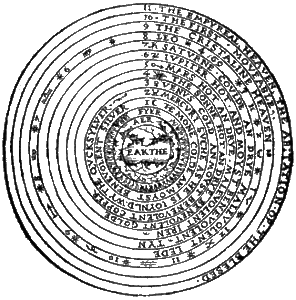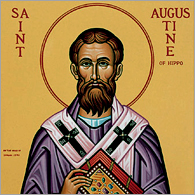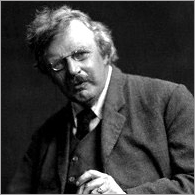Exaggeration, to the point of falsehood. It’s a central characteristic of the new geocentrism. It occurs in the geocentrists’ treatment of science. It permeates their handling of the Bible. It’s part and parcel of their theological case. And in this article we’ll see that this tendency toward fanciful exaggeration pervades Robert Sungenis’s treatment of the Church Fathers as well (see many prior instances in “Geocentric Double Standards and Exaggerations on Magisterial Documents”, “Geocentric Exaggerations: The Catechism of Trent”, “Geocentrists Significantly Mangle CMB Science”, and “Robert Sungenis, Physics Major?”)
In an interview given in 2004, Sungenis presented a specific citation from Church Father St. Basil the Great as the single most important patristic witness in support of geocentrism (see interview with Jacob Michael, link). And in Galileo Was Wrong, he explicitly calls this passage a “dogmatic assertion of geocentrism” (9th ed. vol. 2., p. 509n579) and claims that it’s one of the Fathers’ “definitive works” on geocentrism.
Dogmatic Assertion? Really?
“Dogmatic” is an interesting choice of words. In colloquial parlance, dogmatic means to assert something as “certainly correct” and that “cannot be doubted” (link). In theological parlance, which would more closely match Sungenis’s usage as applied to a Father of the Church, dogmatic means that something is formally defined by the Church’s Magisterium as an essential part of the Catholic faith, the denial of which would represent formal heresy.
For this to be a “dogmatic assertion” on St. Basil’s part we would need to see an indication that this belief is a core and unshakable part of the Church’s faith, of continuous belief in sacred Tradition, and upheld by a formal act by the Church’s Magisterium. That’s what “dogmatic” means in Catholic parlance. Do we see any of these features in the passage from St. Basil cited by Sungenis? Certainly not. An examination of the passage in its context shows the claim that this is a “dogmatic assertion of geocentrism” to be yet another gross exaggeration.
But Why is it Central? It Makes a Difference
Now to anticipate, before we forge into this discussion, I think Sungenis would reply that what St. Basil sees as central to his argument (pun intended) is precisely that the Earth is in the center of everything, while one can quibble about the details of how it is supported there, etc. But notice that St. Basil never says that the Earth’s centrality must be so because it’s a matter of divine revelation – rather, he claims it must be so because he adheres to the then-standard Aristotelian cosmology which holds that heavy things fall, that Earth is the heaviest thing in the universe, and that therefore its “natural place” is the center (or “bottom”, as St. Basil says) to which it has fallen:
If stones, wood, all terrestrial bodies, fall from above downwards, this must be the proper and natural place of the whole earth. If, on the contrary, a light body is separated from the centre, it is evident that it will ascend towards the higher regions. Thus heavy bodies move from the top to the bottom, and following this reasoning, the bottom is none other than the centre of the world (Hexaemeron 1:10).
The irony is that the neo-geocentrists strongly reject Aristotle’s cosmology, not only because it falls apart in light of physical evidence (the Earth is obviously not the heaviest thing in the universe), but also because it thoroughly undermines their insistence that being in the physical center is of great existential significance. On the contrary, in the Aristotelian cosmology espoused by the ancients such as St. Basil:
earth’s position at the center of the universe was taken as evidence not of its importance but (to use a term still in circulation) its grossness. . . . Pre-Copernican cosmology pointed not to the metaphysical or axiological “centrality” but rather to the sheer grossness of humankind and its abode. In this view, the earth appears as a universal pit, figuratively as well as literally the world’s [universe’s] low point (Danielson, “The Great Copernican Cliché”, p. 1031; for more see “Geocentrists Peddle Alien Theology of Centrality”).
So even in the portion of text cited by Sungenis there is nothing to indicate that St. Basil sees the centrality of the earth as anything more than the purely natural consequence of Aristotelian notions of matter that even the neo-geocentrists reject.
That Pesky Context Again
More significantly, when we read this passage in its larger context we see that Sungenis has left out material on either side of the passage he cited that further undermines the claim that this is a “dogmatic assertion of geocentrism.” In the material immediately preceding, St. Basil asserts explicitly that the matter he’s going to be discussing is in some ways best left unaddressed, because it’s not edifying:
In the beginning God created the heaven and the earth.” If we were to wish to discover the essence of each of the beings which are offered for our contemplation, or come under our senses, we should be drawn away into long digressions, and the solution of the problem would require more words than I possess, to examine fully the matter. To spend time on such points would not prove to be to the edification of the Church. . . . (Hexaemeron 1:8; emphasis mine.)
How exactly can a matter be of allegedly dogmatic importance and yet, at the same time, “not prove to be to the edification of the Church”? Going further, St. Basil states that the questions themselves are “vain”:
If I ask you to leave these vain questions, I will not expect you to try and find out the earth’s point of support. The mind would reel on beholding its reasonings losing themselves without end. . . . Put then a limit to your thought, so that your curiosity in investigating the incomprehensible may not incur the reproaches of Job (Hexaemeron 1:9).
Then, contemplating the various challenges that the physical details present to one’s reason, St. Basil sidesteps the entire issue and insists that the only “infallible” aspect that commands the Christian’s assent is the bare fact that all these things are sustained by God’s power:
we must still remain faithful to thought of true religion and recognise that all is sustained by the Creator’s power. Let us then reply to ourselves, and let us reply to those who ask us upon what support this enormous mass rests, “In His hands are the ends of the earth.” It is a doctrine as infallible for our own information as profitable for our hearers (Hexaemeron 1:9).
The simple statements that “In the beginning God created the heaven and the earth” and “In His hands are the ends of the earth” are all that St. Basil insists upon as binding for Christians, the only “dogmatic assertions” or “definitive” statements that he makes on the subject. Clearly these fall far short of supporting the neo-geocentric enterprise. Sungenis left all of this preliminary context out of his citation.
Then, in the portion actually cited by Sungenis, St. Basil lays out a quasi-scientific, quasi-philosophical explanation for why the Earth, in his view, occupies the center:
There are inquirers into nature who with a great display of words give reasons for the immobility of the earth. Placed, they say, in the middle of the universe and not being able to incline more to one side than the other because its centre is everywhere the same distance from the surface, it necessarily rests upon itself; since a weight which is everywhere equal cannot lean to either side (Hexaemeron 1:10).
Notice that there is no citation of biblical texts, no appeal to an unbroken lineage of apostolic Tradition, no appeal to any ecclesiastical authority. Rather, the support for all of this is a natural philosophical argument – an argument which, in our own time, we find to be incorrect scientifically:
If stones, wood, all terrestrial bodies, fall from above downwards, this must be the proper and natural place of the whole earth. If, on the contrary, a light body is separated from the centre, it is evident that it will ascend towards the higher regions. Thus heavy bodies move from the top to the bottom, and following this reasoning, the bottom is none other than the centre of the world (Hexaemeron 1:10).
St. Basil believes that this natural explanation may be of some use and comfort to his readers, but in the end he sees the entire matter as one of relative indifference. Notice that he explicitly leaves this an open question:
If there is anything in this system which might appear probable to you, keep your admiration for the source of such perfect order, for the wisdom of God. Grand phenomena do not strike us the less when we have discovered something of their wonderful mechanism. Is it otherwise here? (Hexaemeron 1:10; my emphasis.)
He goes on, then, to point out the varied views of different natural philosophers and warns his readers not to be concerned about these differing views:
We might say the same thing of the heavens. With what a noise of words the sages of this world have discussed their nature! . . . Some have said [etc.] . . . Others have rejected this system as improbable, . . . But yet another fine speaker arises and disperses and destroys this theory to give predominance to an idea of his own invention (Hexaemeron 1:11).
In the end it’s sufficient simply to say that God created all things and that the creation points to God:
Do not let us undertake to follow them for fear of falling into like frivolities; let them refute each other, and, without disquieting ourselves about essence, let us say with Moses “God created the heavens and the earth.” Let us glorify the supreme Artificer for all that was wisely and skillfully made; by the beauty of visible things let us raise ourselves to Him who is above all beauty; by the grandeur of bodies, sensible and limited in their nature, let us conceive of the infinite Being whose immensity and omnipotence surpass all the efforts of the imagination. Because, although we ignore the nature of created things, the objects which on all sides attract our notice are so marvellous, that the most penetrating mind cannot attain to the knowledge of the least of the phenomena of the world, either to give a suitable explanation of it or to render due praise to the Creator, to Whom belong all glory, all honour and all power world without end. Amen. (Hexaemeron 1:11; my emphasis.)
Conclusion
There is nothing here remotely approaching a “dogmatic assertion of geocentrism”. Far from emphasizing the allegedly divine nature of such a belief, St. Basil puts forth purely natural arguments which, today, are known to be incorrect and are rejected even by the neo-geocentrists. St. Basil cites no Scripture in support of his view. He makes no appeal to sacred Tradition, apostolic authority, or magisterial pronouncements. Quite the contrary, he explicitly says that in the end, beyond belief that God made all things and sustains them by His power, the details are matters of indifference.
This fits perfectly with what I stated years ago in my article “Geocentrism and the Unanimous Consent of the Fathers”:
What has struck me in looking into this particular topic is just how consistently, among the Church Fathers and the medieval theologians, these matters of cosmology were treated as matters of natural philosophy and not as matters of faith.
There is no evidence that a consensus of the Fathers and Doctors of the Church treat geocentrism as a matter of divine revelation and therefore binding in faith. The Fathers and medieval theologians accepted geocentrism as the best science of their day and spoke of it in terms of a natural philosophy (most notably Aristotle’s cosmology) that is rejected today even by the new geocentrists. As even Fr. Melchior Inchofer, the anti-Galileo theological consultant for the Holy Office in 1633 said, “Regarding the Holy Fathers it must be noted that they presupposed, rather than argued, that the earth is at rest, in agreement with the common opinion of the philosophers” (from R. J. Blackwell, Behind the Scenes at Galileo’s Trial, p. 119; emphasis mine.)] And, as Fr. Inchofer admitted elsewhere: “I have not found a single one of the Holy Fathers who has dealt with the motion of the earth clearly and positively, as the saying goes. But from some of them it is possible to deduce a few things that seem relevant here (ibid., p. 112.)
Sungenis has advanced this specific patristic citation from St. Basil the Great as the best he has in favor of geocentrism as Catholic doctrine. As such, it looks like he doesn’t have much.






